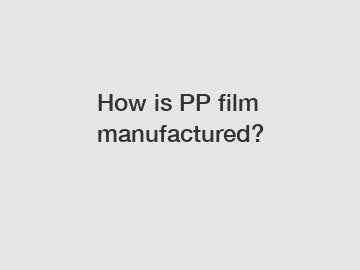How is PP film manufactured?
How is PP Film Manufactured?
Polypropylene (PP) film is a versatile and popular material used in various industries for packaging, labeling, and other applications. Understanding the manufacturing process of PP film gives us insights into its composition and why it is a sought-after material. In this article, we will delve into the step-by-step process of how PP film is manufactured.
Raw Material Extraction.

The first step in manufacturing PP film involves extracting the raw material, which is polypropylene resin. Polypropylene is a thermoplastic polymer derived from the propylene monomer. This resin is obtained through a refining process, which involves fractional distillation of crude oil or natural gas liquids. Once extracted, the polypropylene resin is ready to be processed into film.
Polypropylene Extrusion.
The next stage of manufacturing PP film is the extrusion process. Extrusion is a commonly used method for producing plastic films. In this process, the polypropylene resin is melted down and forced through a flat or circular die, forming a thin, molten sheet. The thickness of the film is determined by the gap between the rollers and the die's size. The molten sheet is then cooled down using a set of cooling rollers.
Film Orientation.
After the initial extrusion, the PP film goes through a film orientation process. This step involves stretching the film in either the machine direction (MD) or cross direction (CD) to enhance its mechanical properties. Orientation improves the film's tensile strength, tear resistance, and clarity. This stretching process is achieved using specialized equipment such as orientation lines or tenter frames. The film is heated, stretched, and cooled to lock in the new molecular arrangement.
Slitting and Winding.
Once the PP film is fully oriented and has reached its desired properties, it is ready to be slit and wound. Slitting involves cutting the film into narrower widths suitable for specific applications, such as packaging or labeling. This process is carried out using precision slitting machines that ensure clean and accurate cuts. The slit film is then wound onto large rolls for easy handling and storage.
Surface Treatment and Printing.
To enhance the film's printability and adhesion properties, a surface treatment is often applied. The surface treatment process involves exposing the film to corona discharge, which creates micro-cracks on the film surface. These micro-cracks improve ink adhesion and allow for better printing quality. After the surface treatment, the PP film can be printed using various methods, such as flexographic or gravure printing, depending on the desired outcome.
Final Inspection and Packaging.
Before the PP film leaves the manufacturing facility, it undergoes a thorough inspection to ensure quality control. Quality control measures involve checking the film for visual defects, such as holes, scratches, or color inconsistencies. Additionally, the film's thickness, dimensions, and other specifications are verified to meet customer requirements. Once passed, the film roll is securely packaged, ready for shipment to customers around the world.
In conclusion, the manufacturing process of PP film involves extracting raw polypropylene resin, followed by extrusion, film orientation, slitting, surface treatment, printing, final inspection, and packaging. Each step ensures the production of high-quality PP film with desirable properties. PP film's versatility and wide range of applications make it a valuable material in numerous industries.
If you have any further questions about PP film or would like to explore its applications, please don't hesitate to contact us.
If you want to learn more, please visit our website silicone release liner manufacturers, types of bopp bags, bopp metallized film.
129
0
0


Comments
All Comments (0)